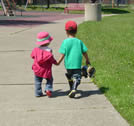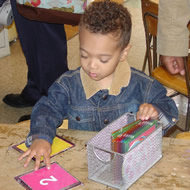FINDING GOOD CHILD CARE You may be looking for child care as a part-time opportunity for your children or as a requirement for you to work full time outside your home. The criteria are surprisingly similar except that consistency and communication between home and school are even more critical if your children will spend a fair amount of their day away from home. The communication between school and home is important not only because you will feel more secure about the environment that is being provided for your children, but also because you, as parents, can share in your children's development and milestones despite your not being able to be with them much of the time. You will want to actually visit and observe a day-care center or preschool that you are considering for your children. A list of criteria for you to consider follows. ATMOSPHERE Child-care providers should be loving toward all the children. If staff members seem to be targeting some children as troublemakers in their conversations, consider that your children could become one of those children, and that would not be a good school start. STAFF You will first want to notice the staff-to-child ratio. Ask about the education and training of the staff as well. Stability is also important. Schools that have a history of continuous staff turnover may either not be selecting staff well or not training them sufficiently. Obviously, occasional changes of staff are normal. You can obtain that information best from other parents who have had children at the school for awhile. CLASSROOM ORGANIZATION
Most day-care centers and preschools foster the love of books, since reading is a prerequisite to the love of learning. Several story hours a day should not be replaced by a convenient television set, and television should either make up a very small part of children's learning in preschool or not be present at all.
Toys and equipment should include painting and drawing supplies, puzzles, small and large building blocks, pretend and imaginative toys, as well as sturdy outdoor equipment. An atmosphere where children are expected to explore, create and invent, feel and touch rather than copy adult direction only, and fill in lines on work pages, underscores a creative environment. MUSIC, DANCE, AND MOVEMENT Creative movement provides opportunities for the development of children's love of music and rhythm. Dance or some form of movement to music should be part of almost every preschool day. Music has also been found to be important for early brain development.
The exploration of nature may be limited at urban centers, but learning about weather, animals, and nature can be carried out at parks and playgrounds and are important for children. VALUE SYSTEMS Religious points of view, values about honesty, respect, animal life, conservation, etc., should be a reasonable match with your family values.
Preschool should be providing some academic preparation, but not too much. A more holistic approach is important for children to develop appropriately. By age four, more academic preparation begins to be introduced. FREEDOM TO CHOOSE WITHIN LIMITS Some school curriculums are the same for the whole class, and others permit children to make all of the choices based on their interests and development. Rigid preschool lessons will not tap individual differences. Allowing the children to make all of the choices of activities is also risky. Children are likely to select their areas of interest and pursue them but may ignore or neglect some of the more boring skills they may require for kindergarten.
If your child will be eating breakfast or lunch at the day-care center, ask about the nutritional program and alternatives for food. Hot lunches can be very nice for a two-career family that doesn't have time to prepare a hot meal in the evening.
Check also to see how the center's nap schedule fits with your children's present routine. You may need to make some changes in your child's routine if there are problems, or you may want to ask the center to make adjustments for your children. DECISION MAKING Firsthand observations of a preschool class in session, using a checklist (see below), and making notes will help you to evaluate these criteria and some personal issues of your own. An interview with the teacher and some telephone calls to other parents will assist you in gathering other information. Sifting through your information with consideration for your personal priorities will lead you to comfortable decision making.
*Excerpted from Raising Preschoolers, Sylvia Rimm, Ph.D., Crown Publishing, 1997. ©2010 by Sylvia B. Rimm. All rights reserved. This publication, or parts thereof, may not be reproduced in any form without written permission of the author. |
|||||||||||||||||||||||||||||||||||||||||||||||||||||||||||||||||||||||||||||||||||||
©2010 by Sylvia B. Rimm. All rights reserved.
Report any problems with this site to Webmaster@sylviarimm.com

 Reasonable organization and limit setting are critical for children's early learning of responsibility and self-discipline. Routines that teach children good manners, cleanup responsibilities, consideration for others, and respect for teachers in charge provide good preparation for school. Disorganized, out-of-control class environments will cause feelings of insecurity for your childre.
Reasonable organization and limit setting are critical for children's early learning of responsibility and self-discipline. Routines that teach children good manners, cleanup responsibilities, consideration for others, and respect for teachers in charge provide good preparation for school. Disorganized, out-of-control class environments will cause feelings of insecurity for your childre.
 OUTDOOR PLAY AND EXPLORATION
OUTDOOR PLAY AND EXPLORATION

